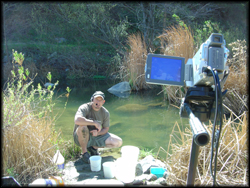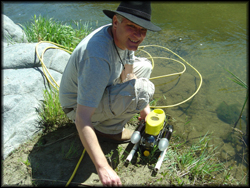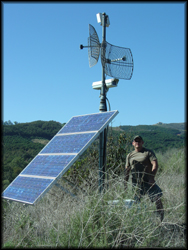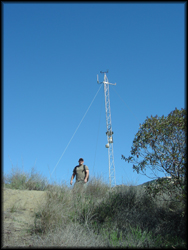 8am
8am
After driving about sixty miles from my home in the city of San Diego, I met up with Pablo at the gate of the rural reserve and we headed to the river gorge where he was participating in a Live Interactive Virtual Exploration (LIVE) activity with Hans-Werner Braun, a research scientist at the University of California-San Diego.
 Specifically, Pablo and Hans-Werner spent the morning touring students around the riverbed via an underwater robot equipped with a camera and also conducted water quality tests � all while the students were attending a High Tech Fair some sixty miles away in urban Del Mar.
Specifically, Pablo and Hans-Werner spent the morning touring students around the riverbed via an underwater robot equipped with a camera and also conducted water quality tests � all while the students were attending a High Tech Fair some sixty miles away in urban Del Mar.
 1pm
1pm
Once the LIVE activity was finished, we had a very quick lunch and then headed up a mountaintop to do some routine maintenance on one of the solar-powered telecommunications sites. We found a half-eaten cable (I guess coyotes like to gnaw), which needed repair and then continued our hike.
 2pm
2pm
By mid-afternoon, we were checking on another telecommunications site � this one a bit farther up the mountain. Housing one of 30 hydroclimate stations scattered throughout the reserve, the site tools are run by researchers at the Scripps Hydroclimate Weather Observation Program and measure air temperature, atmospheric pressure, relative humidity, solar radiation, total precipitation, wind direction, and wind speed. This site wasn't in need of any repair, so after Pablo did some basic cleaning, we started our trek back down the mountain.
5pm
Finally, it was time to call it a day and I headed back home in my sweaty clothes and muddy shoes: sore back, sunburned cheeks, windblown hair, and dry red eyes. Suffice it to say that when my kids asked me "Did you have fun on your fieldtrip today, Mommy?", I just had to shake my head, laughing and realizing...Pablo's job not only requires great intelligence, but also that sort of physical stamina that I must have lost somewhere in my twenties!
-Kimberly Mann Bruch
San Diego Supercomputer Center, University of California - San Diego

